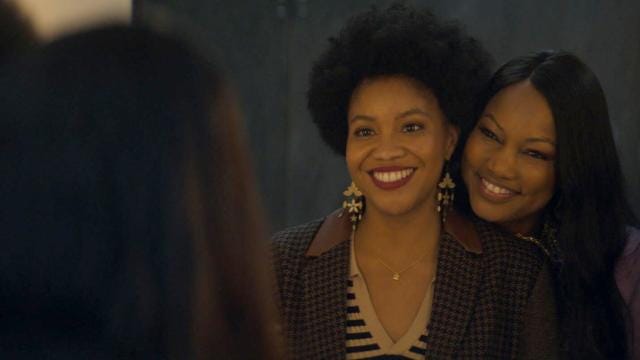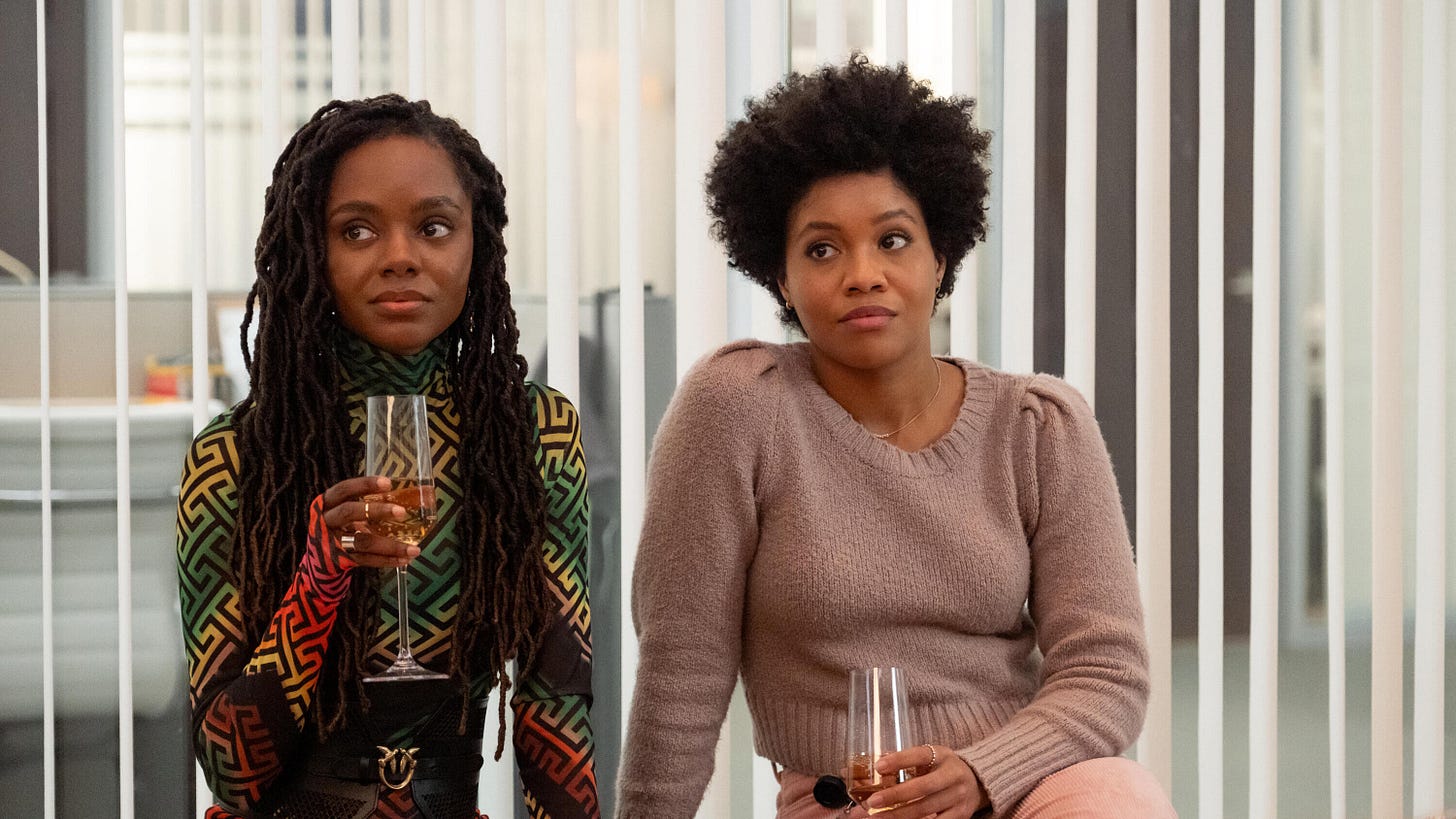I came into The Other Black Girl almost completely cold. I hadn’t read the novel by Zakiya Dalila Harris that the show is based on, and somehow managed to miss just about every trailer for it. Based on the title and promo photos, I guessed that it was the latest in the post-Get Out wave of racial horror stories.
The story follows awkward bookworm Nella, initially resigned to her role as The Only Black Girl at the prestigious publishing firm Wagner Books. She’s an assistant to editor Mellie Grant Vera Parini, a frantic white feminist who dangles the carrot of a possible promotion to keep Nella striving and not complaining about the overwhelming whiteness of her workplace and its output. CEO and nepo-baby Richard Wagner swans in and out of the office in layers of tweed and cashmere, making “jokes” about his wealth and power in that way that wealthy and powerful people think is self-deprecating. Outside of Wagner, Nella has her blandly supportive white boyfriend Owen (played by Will Gardner’s murderer, so, may all his wishes turn to ash in his mouth); and her queer best friend Malaika, who is louder, more confident, more skeptical, and darker-skinned than her protagonist bestie. But suddenly, into this mediated greige environment appears Hazel, the titular other Black girl who seems ready to provide Nella with some much-needed racial relief.
SPOILERS FOR THE OTHER BLACK GIRL BELOW. STICK TO THE ROADS.
All of this material probably sounds pretty familiar, and some of that is intentional. Especially when it comes to Nella’s workplace, we as the audience are meant to murmur with recognition at the personalities and dialogue beats. But it also has the unfortunate effect of dampening any legitimate tension for much of the show. There’s no possibility of surprise when Nella criticizes the latest book from Wagner’s star author for being racially problematic, and Vera’s “supportive” “advice” is for Nella to say nothing. And no possibility of more than a knowing half-chuckle whenever earnest white liberal colleague Sophie awkwardly tries to prove her ally bonafides. Part of the problem with being part of that post-Get Out horror wave is that we know all these beats already.
The lack of surprises doesn’t just defang the show’s satire, but it also deflates the spookiness. Comedy and horror both depend on the unexpected to provoke a genuine reaction, but The Other Black Girl’s horror elements never escalate beyond “a bit weird.” And by the time we get to the final episodes, all the hints towards the supernatural get dropped or undermined in favour of a decidedly human antagonist.
Nella is completely in thrall to the idea that having “someone who looks like me” writing books is the endgame worth doing anything for, and it makes her very easy to manipulate. She ignores the bright red flags that Hazel throws up. She allows her publishing company to mollify her by re-releasing her favourite book, originally edited by the only Black female editor in the company’s history, rather than finding and nurturing new Black writers. And she lets herself fall under the spell of her favourite author, Diana Gordon, the queen of #RepresentationMatters played with cool relish by Garcelle Beauvais. Diana is ultimately revealed as the mastermind behind all of the sinister machinations of the show. The Big Bad isn’t the CEO of this publishing firm, who represents the unchanging power of the white patriarchy. It’s a Black woman who was willing to compromise the ending of her book to satisfy a white audience, and now sees it as her life’s mission to convince other Black women to make similar compromises for their own success and respectability.

Making the Big Bad in a racial horror story a Black woman is a fascinating choice. There’s some really rich subtext about Black elite social groups like Diana’s #BGM cult, that provide their members with status, but very little in terms of an authentic connection or community. I so wish we had spent more time interrogating that, and how those groups often wind up recreating all of the harmful power dynamics and values of racialized capitalism and patriarchy, even when there are no white people around.
To me, the most interesting tension that this show didn’t entirely tease out is the one between Black people who are used to—and sometimes even enjoy—being The Only One in the Room. Nella has internalized everything about Wagner, from its drab colour palette to the tragic lie of a belief that she can “change things from the inside.” The lackadaisical shape and moisture level of her fro let me know right away that she hasn’t been around a lot of Black people in a while. (It also let me know that we were in for some type of Evil Relaxer subplot. [It was Evil Hair Grease.]) Once the incredibly stylish and goddess loc’d Hazel arrives, it’s only a matter of time before Nella goes through the same awakening that I did when I started working somewhere with multiple Black femmes around, because now there’s people around you Monday to Friday who know 8-week-old box braids when they see them.
Hazel also has all the trappings of the Black woman who comes into an all- or mostly-white space and thrills everyone at first with her appealingly exotic Blackness. There are the aforementioned goddess locs. There’s the colourful and ostentatiously stylish attire that is totally perpendicular to the muted neutrals that everyone at Wagner—including Nella—dresses themselves in. There’s the fact that she went to an HBCU and lives in Harlem. All of this thrills white people in white spaces for the first couple of months, and Hazel cheerfully leans all the way into her perceived exoticism. What we don’t get to see is how the thrill of the New Blackness curdles into the same racist resentment every time. The fact of your Black presence in their white environment stops being a feather in their cap and starts being an eyelash in their eye. They initially love how you speak truth to power, but after a few months, they remember—they are power, and actually, they don’t like how you speak to them. If this story continues, I would love to see that dynamic play out.
The Other Black Girl isn’t nearly as egregious as, say, Antebellum; but it also doesn’t achieve the same audacious horror heights as something like Lovecraft Country. It occupies an awkward middle ground between workplace satire and supernatural horror, and ends the season on a pretty muddled cliffhanger to boot. Here’s hoping that a second season chooses between those two genres, and really dives into the potential there.





